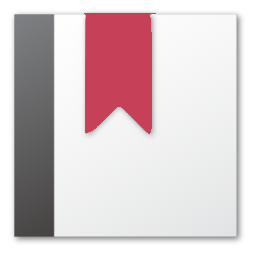
Jerusalem
“He holds His priesthood permanently, because He continues forever.” (Hebrews 7:24)
During the period of the Tabernacle in the wilderness and the First Temple in Jerusalem, high priests were anointed with oil and had a similar status among the people as the anointed king.
Both were set apart to do the work of the Lord (YHVH).
Yeshua (Jesus) fulfilled both roles, not only as our King of Kings but also as our High Priest forever, which has been foreshadowed in Scripture since the days of Abraham.
Anointed in Hebrew is Mashiach or Messiah. So, what does it mean that Messiah Yeshua is both our anointed King and High Priest?

Moses anoints his brother Aaron with oil as the first High Priest (Exodus 40:12–15). Yeshua was anointed by God Himself as He rose from the waters of the Jordan during His baptism (Illustration: 1890 Holman Bible)
King and Priest Rolled into One
In the Torah (the first five books of the Bible) the king and high priest each had their own genealogy: kings descended from the tribe of Judah and the High Priests descended from the tribe of Levi, specifically from Aaron, the first High Priest.
The Jewish People were expecting that one day a Messiah would come as king and be a descendant of King David, who was from the tribe of Judah.
But they never thought king Messiah would also be a priest — that is, until God told the Prophet Zechariah to put a crown on the High Priest Joshua:
“Take silver and gold, make an ornate crown and set it on the head of Joshua the son of Jehozadak, the high priest. Then say to him, ‘Thus says the LORD of hosts, Behold, a man whose name is Branch, for He will branch out from where He is; and He will build the temple of the LORD.
‘Yes, it is He who will build the temple of the LORD, and He who will bear the honor and sit and rule on His throne. Thus, He will be a priest on His throne,’” (Zechariah 6:11–13)
This passage is a vivid picture of Joshua as a symbol of things to come. We know this because God said so very clearly:
“Listen, High Priest Joshua, you and your associates seated before you, who are men symbolic of things to come: I am going to bring my servant, the Branch.” (Zechariah 3:8)
The High Priest Joshua would be a symbol of the Branch, who would be a Righteous King, and the Messiah.

King David Playing the Harp, by Gerard van Honthorst
In fact, the ancient translation of Zechariah into Aramaic that was read to the Jews in the synagogues (known as a Targum), declares who this Branch is:
“Behold the man Messiah is his name.” (Zechariah 6:12, Targum Jonathan)
Let’s look at each piece of this portrait to see how Joshua symbolizes the Messiah.
Joshua → Yeshua
In Hebrew, Joshua’s name is Yehoshua. The short form of this name is Yeshua. Both Yehoshua and Yeshua mean “The LORD saves.”
Joshua → The Branch → Righteous King → Messiah
Joshua is symbolic of a Righteous Branch, which the Prophet Jeremiah explained would be a king:
“The days are coming,” declares the Lord, “when I will raise up for David a righteous Branch, a King who will reign wisely and do what is just and right in the land.” (Jeremiah 23:5)
It is widely understood, even to this day in Judaism, that this righteous Branch, who is a descendant of King David, refers to the Messiah.
As the Jewish People were about to leave Israel for exile in Babylon, however, the Prophet Ezekiel told the people that their Davidic dynasty would be suspended until someone comes who is worthy to receive the crown of a king and the garments of a priest:
‘And you, O slain, wicked one, the prince of Israel, whose day has come, in the time of the punishment of the end, thus says the Lord GOD, ‘Remove the turban and take off the crown; this will no longer be the same. Exalt that which is low and abase that which is high.
‘A ruin, a ruin, a ruin, I will make it [the throne of David]. This also will be no more until He comes whose right it is, and I will give it to Him.’” (Ezekiel 21:25–27 / verses 30–32 in Hebrew Bibles)
This prophecy reveals that the kingship of Israel will be suspended until God brings forth someone who will be both king and priest (the crown represents the king; the turban represents a ceremonial garment of the High Priest).
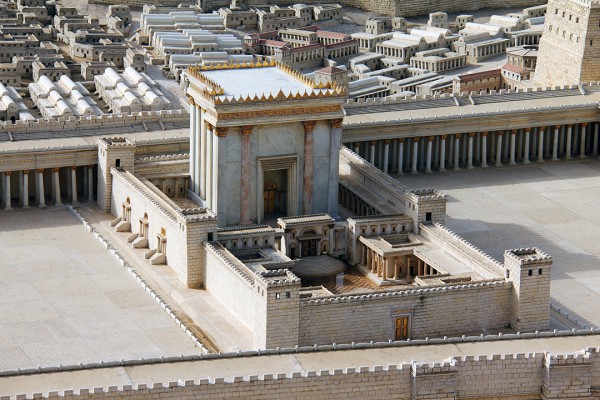
Model of the Second Temple, completed by King Zerubbabel and the High Priest Joshua in 515 BC and later refurbished and expanded by King Herod about 19 BC.
The Branch / Messiah will build the Temple of the Lord
The High Priest Joshua and King Zerubbabel were given authority to rebuild the physical Temple after returning from exile in Babylon (Ezra 5:2).
However, the Branch (Messiah) would rebuild another Temple not made by hands. Yeshua explained this to the Pharisees when He said:
“’Destroy this temple, and in three days I will raise it up.’ … He was speaking of the temple of His body.” (John 2:19–22)
The same Glory of the Lord that once filled the Temple building filled the physical body of Yeshua. It is the same Glory that He revealed to Peter, James, and John on the Mount of Transfiguration.
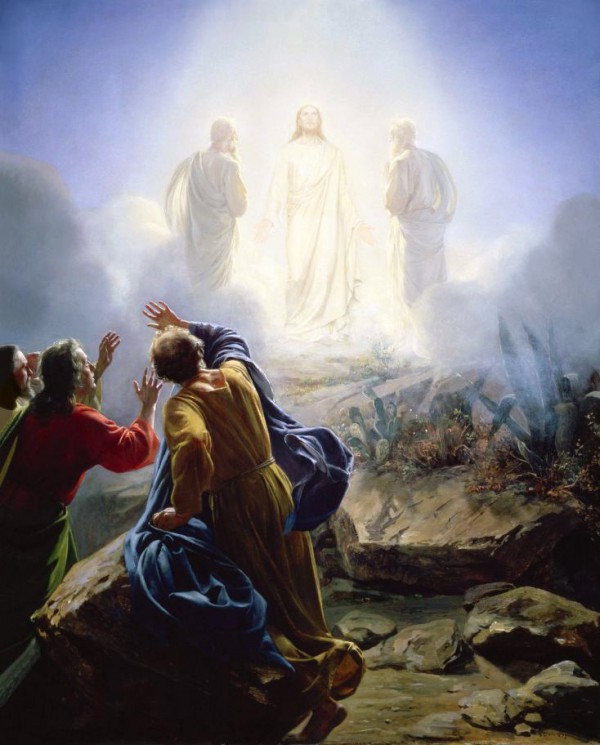
Transfiguration of Messiah, by Carl Heinrich Bloch (1800s)
The High Priest Has Legal Right to Approach God
The High Priest (Kohen HaGadol) was the only person who had the legal right to enter the Holy of Holies where God’s Glory resided.
If an unauthorized person approached God, it meant certain death (Exodus 19:21).
There, in God’s Presence, the High Priest would confess the sins of the nation, sacrifice a bull and a goat, and make atonement for himself and for the entire nation of Israel.
It would seem that Yeshua being the Messiah already had the legal right to enter God’s Glory.
That is true in the heavenly realm, but in His human body Yeshua needed the legal right here on earth to stand in the Presence of God and make atonement for us with His human blood.
He, therefore, needed to be our High Priest, as the writer of the Book of Hebrews explains:
“When Messiah appeared as a High Priest of the good things to come, He entered through the greater and more perfect tabernacle, not made with hands, that is to say, not of this creation; and not through the blood of goats and calves, but through His own blood, He entered the holy place once for all, having obtained eternal redemption.” (Hebrews 9:11–12)

The High Priest (left) and other priests (right) wore special garments as an outward reminder that they were set apart for God. (photo: Temple Institute)
The High Priest Would Sit on a Throne and Become King
As noted above, by placing a crown on the High Priest Joshua, he represented the Branch (Messiah) to come who would not only be a king from the line of David but also a High Priest.
“It is he [the Branch] who will build the temple of the Lord, and he will be clothed with majesty and will sit and rule on his throne. And he will be a priest on his throne. And there will be harmony between the two.” (Zechariah 6:13)
The Psalmist (perhaps King David himself) acknowledged that the Messiah would be Lord, King, and Priest forever:
“The Lord says to my lord: ‘Sit at my right hand until I make your enemies a footstool for your feet.’ The Lord will extend your mighty scepter from Zion, saying, ‘Rule in the midst of your enemies … the Lord has sworn and will not change his mind, you are a priest forever, in the order of Melchizedek.’” (Psalm 110:1–4)
This passage is important because God often confirms His plans more than one way; here, He confirms that Messiah would be both a priest and a king similar to Melchizedek (Genesis 14:18–20).
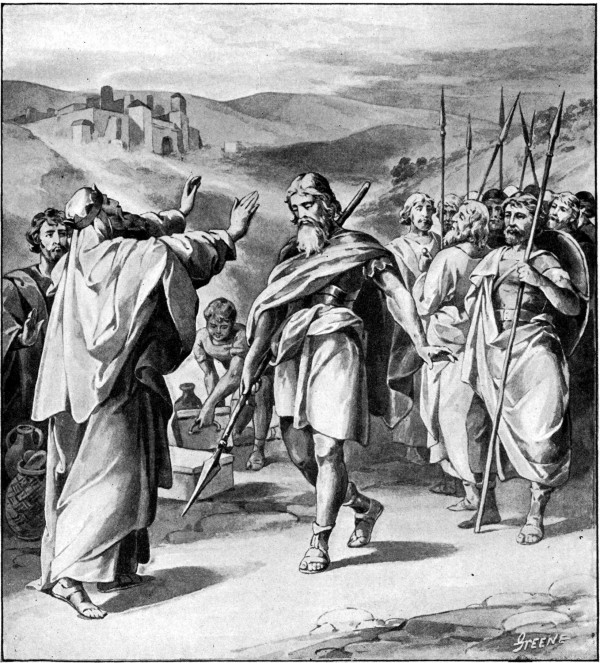
Melchizedek Blesses Abraham (1897), by Charles Foster
Melchizedek’s name means King of Righteousness, which itself foreshadows Messiah. As the Prophet Jeremiah said:
“In His days Judah will be saved, and Israel will dwell securely; and this is His name by which He will be called, ‘The LORD our righteousness [Adonai Tzidkeinu – יְהוָ֥ה צִדְקֵֽנוּ].’” (Jeremiah 23:6)
Melchizedek was also the king of Salem (which later became Jerusalem) and priest to El Elyon (the Most High God) in the days of Abraham.
This foreshadows Yeshua, who is the King of Israel, King of the Jews, and King of all kings even now as He sits on his throne in the heavenlies.
In the future after He comes back riding on the clouds (Daniel 7:13), He will reign from Jerusalem in the earthly Messianic Kingdom.

Yeshua prays to our Father in heaven.
The High Priest Is Our Mediator and Intercessor
One of the most significant roles of every priest was that of intercessor.
As the writer of Hebrews wrote: “Because Yeshua lives forever, He has a permanent priesthood. Therefore, He is able to save completely those who draw near to God through Him, because He always lives to intercede for them.” (Hebrews 7:24–25)
Priests were mediators of the covenant God made with the People of Israel on Mount Sinai. Every day, the priests interceded for the people in several ways:
Sacrificing unblemished lambs and other animals.
Burning Incense, which represented the sweet aroma of the confession, prayers, and atonement of sinners rising up to God in the heavenlies.

The High Priest is burning incense at the altar of incense inside the Tabernacle. The Holy of Holies is in the background. (1890 Holman Bible)
Praying for the people of Israel, confessing their sins.
Making atonement for the people by sprinkling the blood of the sacrifice over the altar. This covered a person’s sins for a while.
In addition to doing all of this, one day a year the High Priest actually entered the presence of God inside the Holy of Holies to sacrifice, pray, and make atonement for the entire nation of Israel.
Priests were specifically set apart by God to perform these holy activities and live especially holy lives.
They purified themselves before entering the Temple and followed rules that other Israelites did not have to follow, such as who they could marry, where they could live, and more.
Yeshua, who had no sin, was the most holy of all priests. He sacrificed His own unblemished self to pay the wages of our sin, which is death (Isaiah 53).
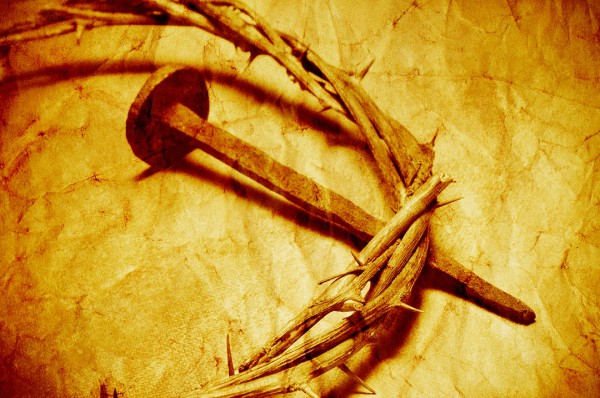
Before Yeshua died, the Romans placed a crown of thorns on His head, symbolic of His role as King of the Jews, a title given to Him soon after His birth (Matthew 2:3). The sign on the execution stake above His head read, “Yeshua of Nazareth, King of the Jews.” (John 19:19)
Yeshua did all of this as the High Priest of a New Covenant in which He would forgive the iniquities of the people and “remember their sins no more” (Jeremiah 31:34).
“Such a High Priest truly meets our need — one who is holy, blameless, pure, set apart from sinners, exalted above the heavens. Unlike the other High Priests, He does not need to offer sacrifices day after day, first for His own sins, and then for the sins of the people. He sacrificed for their sins once for all when He offered Himself.” (Hebrews 7:26–27; also Hebrews 8:6–13)
What this means is very exciting for us — Yeshua, right now, is our Great High Priest (Kohen HaGadol), who has made the final sacrifice for our sins. He sits in the Presence of God, continuously hearing our prayers, making intercession for His brothers and sisters before the Father.
He is our only Mediator. There is no one else qualified to be our High Priest in this regard.
Better than any prayer partner, He knows your needs perfectly, and is praying for you! So, it is in the name of Yeshua (Jesus) that we pray and give God all the praise.



